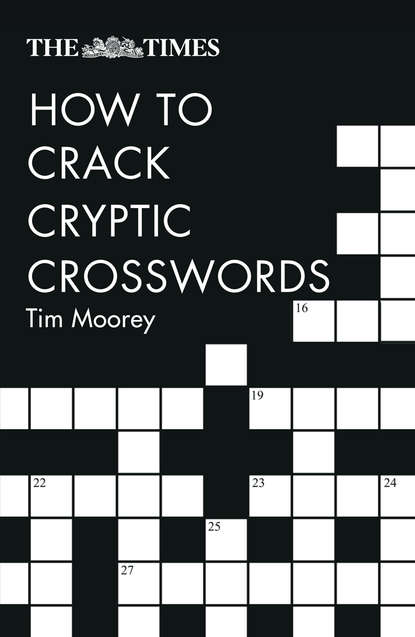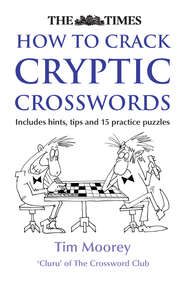По всем вопросам обращайтесь на: info@litportal.ru
(©) 2003-2024.
✖
The Times How to Crack Cryptic Crosswords
Настройки чтения
Размер шрифта
Высота строк
Поля
In many crossword circles this is also known as & lit. However, I have found my workshop participants usually consider this too cryptic a name! It actually means “and is literally so” but people tend to puzzle over that at the expense of understanding the concept.
In fact, it is a simple one that I prefer to call all-in-one, which is what it is: the definition and wordplay are combined into one, often shortish sentence which, when decoded, leads to a description of the solution.
ALL-IN-ONE CLUE: Heads of the several amalgamated Russian states (5)
This clue relies on the letter selection indicator heads (see here (#ulink_527460eb-77e2-5135-be74-102d605104d8)) to provide the solution. Most of the clueing techniques outlined earlier can be used to make an all-in-one clue (see examples in Chapter 8 (#litres_trial_promo), here (#litres_trial_promo)), always provided that the definition and wordplay are one and the same.
Probably the commonest type is an all-in-one anagram, with an anagram as part or all of the wordplay and no extra definition needed because it has been provided by the wordplay. Here is an example:
ALL-IN-ONE ANAGRAM CLUE: A pot’s stirred with one? (8)
Incidentally, this clue demonstrates how punctuation can give you some help with a clue. The question mark is telling you that a pot isn’t necessarily stirred with a spoon but it may be. For examples of when punctuation is not so helpful, see Chapter 4 (#ulink_49035318-af78-5c19-9323-d4b3fcbf1069), here (#ulink_42e0a649-b807-5749-9180-76511a0fa857).
The remaining four types
Now we will focus on the remaining four clue types. Remember that these four only very rarely include indicators within the clue sentence. Here they are together in one chart from which we will proceed to examine each one in turn, starting at the top and going clockwise.
How do we recognize these when no indicator is included?
Punctuation may occasionally be helpful but it’s mainly intelligent guesswork that’s needed. Are these types therefore harder? You can judge for yourself but I’d say not necessarily.
9. The double definition clue
This is simply two, or occasionally more, definitions of the solution side by side. There may be a linking word such as is or ’s, but most frequently there is none, as in this clue.
DOUBLE DEFINITION CLUE: Polish fan (4)
DOUBLE DEFINITION CLUE: Eggs on toast (6)
Indicators for double definition clues:
To repeat, though no specific indicator is given the clue type can often be guessed by its shortness. With only two or three words in a clue, there’s a good chance it’s a double definition. One way of spotting this type of clue is an and in a short clue, as in our next example.
DOUBLE DEFINITION CLUE 3: Bit of butter and jam (6)
10. The additive clue
As we saw at the very beginning of this book, an additive clue consists of the solution word being split into parts to form the solution. Sometimes known as a charade (from the game of charades, rather than its more modern meaning of ‘absurd pretence’), it may be helpful to describe it as a simple algebraic expression A + B = solution C. Here is one with several misleading aspects. Note the use of the linking phrase employed ahead of, telling you to join part A to part B:
ADDITIVE CLUE: Pole employed ahead of young local worker (8)
Indicators for additive clues:
With no specific indicator, it’s a question rather of spotting that A + B can give C, the solution. Sometimes, as in above example, this is made easier by linkwords such as facing, alongside, with, next to, indicating that the parts A and B have to be set alongside each other. In the case of down clues, the corresponding linkwords would be on top of, looking down on and similar expressions, thereby reflecting the grid position of letters to be entered.
11. The cryptic definition clue
There are no component parts at all to this clue, which consists simply of a misleading, usually one-dimensional, way to describe the solution. Depending on how much information is imparted by the clue, it can be very easy or very tough. The best of these clues have an amusing or whimsical air, as in both these examples:
CRYPTIC DEFINITION CLUE: Work at home temporarily? (7,4)
CRYPTIC DEFINITION CLUE: In which all but one in party lose their seats (7,6)
Indicators for cryptic definitions:
The nature of this clue type is such that no indicator is ever given. It can be identified either from the fact that nothing in the clue looks like an indicator, and/or from the presence of a question mark. A tip is to look hard at words which have more than one meaning and then think below the surface. Otherwise, wait until some intersecting letters are available.
12. The novelty clue
From the inception of crypticity in crosswords, there have been innovative clues conforming to no single pattern which defy categorization into any of the preceding groups. These clues are often solved with extra pleasure.
The setter has found it possible to exploit coincidences or special features of a word. As with the cryptic definition type, the solver is asked to think laterally and throw away any misleading images created by the clue. In some rare circumstances when an especially novel idea is used, there may not even be a proper definition. There are more examples of the novelty clue in Chapter 8 (#litres_trial_promo) but, as a taster, here is one:
NOVELTY CLUE: Eccentric as three-quarters of the characters in Fiji? (5)
TOP TIP – CLUE FREQUENCY
Given the twelve clue types identified, which are the most commonly found? The answer to this is that frequency patterns vary according to setter and newspaper but that the additive, anagram, cryptic definition and sandwich types are the most common; they may indeed account for more than half the clues in many crosswords. It may help you to know that there are rarely more than two or three of the following types in any one puzzle: hidden, homophone, all-in-one, novelty, letter switch.
Letter selection indicators
Before moving on to solving clues, we have to consider how individual letters within clues are signposted. We have seen what sort of indicators go with what sort of clues; now we’ll take a look at another commonly used indicator which is essential to solving skills. Take this clue as an example:
ADDITIVE CLUE: Lettuce constituent of salad, primarily (3)
Experienced solvers would be immediately drawn towards the word primarily as it indicates that the first letter or (as in this case) letters of the preceding words are to be selected as building blocks to the solution. In more complex clues they could then be subject to further treatment, such as forming part of an anagram, but here they are used simply to form cos, the lettuce salad ingredient.
There are many alternative ways of showing that the first letter is to be manipulated in some way. Some of these indicators are: starter, lead, source, opening, top, introduction and so on. They may be extended to the plural form too with the use of, say, beginnings, foremost and heads. Note that bit of, part of and suchlike by long-standing convention always indicate the first letter.
Other positions within words are indicated in a similar fashion. The last letter can be end, back, finally, tail and the middle letter centre, heart, and all of the inside letters of a word can be innards, contents, stuffing.
In their negative takeaway guise, they can be headless, unopened, failing to start; and empty signifies that the whole of the innards of a word is to be removed.
Overleaf are some examples of letter selection indicators at work:
TAKEAWAY CLUE: Endless industrial action in a Scandinavian port (4)
ADDITIVE CLUE: Every second counts for attaché in this Pacific island (6)
After a time, you will become familiar with looking beyond and through the surface meaning of a word doing duty as an indicator so that you realise what you are required to do to the relevant letter(s) or word(s).
TOP TIP – LETTER SELECTION INDICATORS
Beware letter selection indicators that, depending on the setter’s policy, can do double or triple duty:
Endless: take away last letter only, or first and last letters.
Head: first letter, or take away first letter (in its sense of behead).






